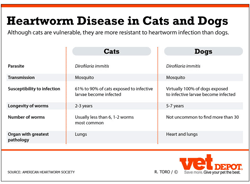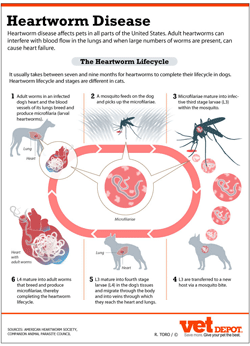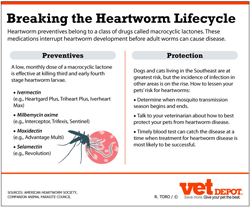Heartworm disease affects pets in all parts of the United States. Dogs and cats living in the Southeast are at greatest risk, but the incidence of infection in areas with a past history of low heartworm rates is now also on the rise.
"Left untreated, heartworm disease is often fatal for both dogs and cats."
Effectively preventing heartworms in dogs and cats requires an understanding of the parasite’s lifecycle and the way in which heartworm preventive medications break that cycle to prevent disease.
The Heartworm Lifecycle
Dogs and some of their wild relatives (e.g., coyotes, foxes, and wolves) are the natural hosts for the heartworm (Dirofilaria immitis) parasite. Other animals, including cats and ferrets, can also be infected, but they play little if any role in the transmission of heartworms to uninfected individuals.

Adult worms within a dog’s heart and blood vessels of the lungs mate and produce microfilariae, juvenile heartworms, that circulate through the animal’s bloodstream. When a mosquito bites a dog with circulating microfilariae, the juvenile parasites are transmitted to the mosquito along with the blood meal.
There, they develop for a couple of weeks and eventually migrate to the mosquito’s mouthparts. At this point, the heartworms are described as infective, third-stage larvae (L3). When this mosquito bites another susceptible host (dog, cat, ferret, etc.), it deposits a drop of its own blood that contains third-stage larvae on the surface of the animal’s body. The L3 enter the new host’s body through the puncture wound left behind by the mosquito.
The larvae enter the animal’s subcutaneous tissues and mature into fourth-stage larvae (L4). The L4 migrate through the body during which time they develop into immature adult worms. They eventually penetrate veins and are carried to the heart and lungs. Once residing in blood vessels within the lungs, juvenile worms continue to mature. Some can eventually become up to 14 inches in length. It takes approximately 50 to 70 days for third and fourth stage larvae to mature into adults.

Under typical conditions, it takes between seven and nine months for heartworms to complete their lifecycle in dogs. The timing and details are somewhat different in cats, but for both species, adult heartworms and all larval stages incite a strong inflammatory response from the host animal which can result in significant injury to the tissues through which the parasites move and reside. Adult heartworms also interfere with blood flow through the vessels in the lungs, and when large numbers of worms are present, they essentially “back-up” into the right side of the heart, resulting in a type of heart failure called “caval syndrome.”
Left untreated, heartworm disease is often fatal for both dogs and cats.
How Preventives Break the Heartworm Lifecycle
Heartworm preventives like Heartgard Plus or Trifexis don’t stop dogs and cats from being infected with third-stage heartworm larvae, but when given as directed, they are very effective at killing the juvenile parasites before they mature and migrate to the heart and lungs. The word “preventive” refers to the prevention of heartworm disease, not heartworm infection.

A low, monthly dose of a macrocyclic lactone is almost 100% effective at killing third and early fourth stage heartworm larvae. However, as heartworm larvae continue to mature into the late L-4 stage, macrocyclic lactones become less effective, and this trend continues the older the worms become. Therefore, heartworm preventives intended for oral and topical use are designed to be given every 30 days to ensure that no larvae has a chance to mature into a resistant stage of development before it is killed through exposure to a macrocyclic lactone.
This mechanism of action has important implications with regards to missed doses. Dogs or cats that receive a dose of heartworm preventive a few days later than scheduled should be fine. However, resistant juvenile adult worms can develop in as little as 52 days, which means that one missed, monthly dose puts pets at risk for heartworm disease.
Heartworm preventives should be given 12 months a year. Determining exactly when mosquito transmission season begins and ends and appropriately timing doses of macrocyclic lactones in response is very difficult. This is particularly true when pets travel outside of their normal home range or unusual weather patterns occur in a particular area.
The Importance of Routine Heartworm Testing
Heartworm preventives are some of the safest and most effective medications used in veterinary medicine today. Unfortunately, no drug works perfectly under all circumstances, so heartworm tests are still vital to preventing fatalities from heartworm disease. If a pet misses or fails to absorb a dose of preventive or comes in contact with a resistant strain of heartworm, a timely blood test can catch the disease at a time when treatment for heartworm disease is most likely to be successful.
Sources
Key factors influencing canine heartworm, Dirofilaria immitis, in the United States. Brown HE, Harrington LC, Kaufman PE, McKay T, Bowman DD, Nelson CT, Wang D, Lund R. Parasite Vectors. 2012 Oct 30;5:245.
Mosquito vectors of dog heartworm in the United States: vector status and factors influencing transmission efficiency. Ledesma N, Harrington L. Top Companion Anim Med. 2011 Nov;26(4):178-85.
Heartworm biology, treatment, and control. Bowman DD, Atkins CE. Vet Clin North Am Small Anim Pract. 2009 Nov;39(6):1127-58, vii.
Canine Guidelines. American Heartworm Society. Veterinary Resources. Accessed 12/27/2012.
CAPC Recommendations. Companion Animal Parasite Council. Accessed 12/27/2012.
The above is provided for information purposes only and should not be used for the diagnosis or treatment of any condition.
This information does not cover all possible variables, conditions, reactions, or risks relating to any topic, medication, or product and should not
be considered complete. Certain products or medications may have risks and you should always consult your local veterinarian concerning the treatment of
your pet. Any trademarks are the property of their respective owners.